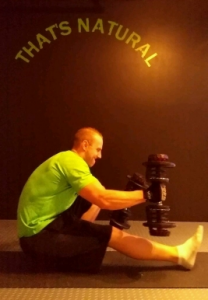Progressions And Deliberate Practice
One thing I have learned to apply in my life over time, and over the vast majority of things I do every day, is the idea of deliberate practice. It has really pushed my success and performance in all aspects of my life. When I got into calisthenics, I also applied it to my training, and noticed much better results.
Deliberate practice is a highly structured and highly engaged activity with the specific goal of improving performance. Deliberate practice when applied to training is different from just working out, or just running, or just lifting weights. When it comes to fitness, it is very structured and goal oriented. It can be applied to all aspects of life, but in fitness, it can be very powerful – especially for calisthenics.
In calisthenics, we use “progressions” to reach goals in strength and difficulty. It’s no different than adding weight when you are using barbells, for instance. You are increasing leverage on the body.
The problem with these progressions is they are too far apart from one another, and in fact sometimes don’t even work in the order they need to because of the gap between them. They should really be called bench marks. Most people don’t like to divulged the true secrets they used in their training. As well, it’s boring behind the scenes. They just like to show the planche they can do now. It’s also pretty uninspiring when people post their “progressions” to get to a certain exercise because they perform the progressions easily since they have already moved through them. It just doesn’t look right unless you show the true work you did to get there.
Convict conditioning is a great example of this. Try going from diamond push up progression to one arm half push up. It’s not easy. You need to make measurable structured differences to bridge the two bench marks and you need to pursue them and practice them with a vengeance. This is where deliberate practice comes in.
To perform deliberate practice, you must follow some key rules. What you’re doing must be intentionally structure to improve performance. Example, doing hand stands for 55 seconds when you can already do hand stands for 55 seconds does not improve your one arm hand stand for instance. Doing 1 arm hand stand work for 2-3 seconds because you are not good at it yet is deliberate practice. Trying to balance on the one hand while constantly failing is deliberate practice. This is just a small example. But you would record you managed 3 seconds on the one hand and push for the smallest sign of improvement next time. Aim for 4 seconds then 5 etc.
To benefit from the intentional “progression”, you have to push yourself. Using one hand instead of 2 for a fraction of the time may seem like its less work, but it’s not. That is the goal of deliberate practice.
To help put deliberate practice into context, lets show you some examples:
Planche:
Hand stand:
Lever:
You will see in these examples, I can easily hold an early progression. But I push myself into the next one with the goal of failing. If I just try and perform the “next progression” for these movements I’m way too far away. Example for planche is straddle to full planche. You must bridge the gap, slowly over small tiny forced improvements that are structured, tracked, and deliberately aimed at what you are trying to achieve
You must track what you are doing! Video, photo, reps, hold counts, weights, all must be tracked or you will not be able to remember exactly where you were to push improvement. You have to track success, make sure you’re diligent about it.
Deliberate practice is laborious. Almost painfully boring. But the final results are well worth it. In calisthenics, it is the difference between fast and slow progression if you take the proper mind set. Once you have installed it in your training, start adding it to other aspects of your life – sports, relationships, work etc. It has no boundaries.





